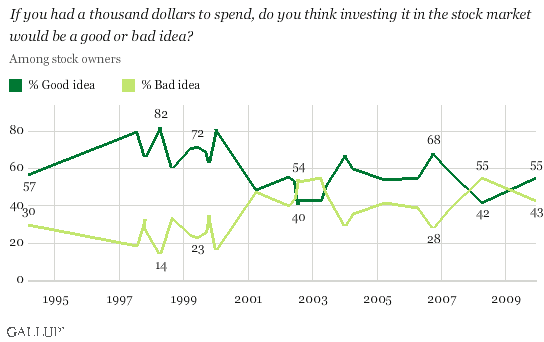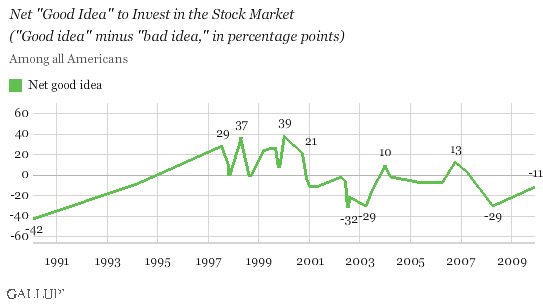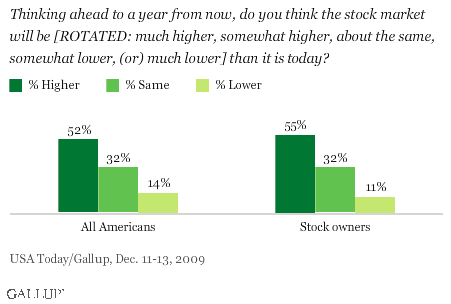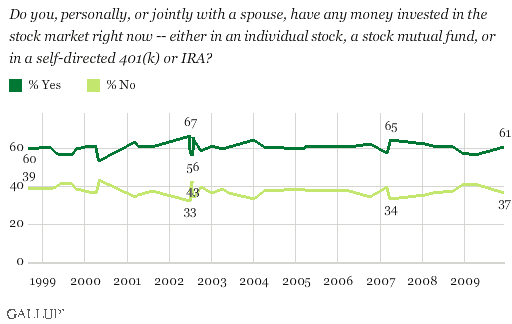PRINCETON, NJ -- Stock owners in the U.S. have become somewhat more optimistic about the stock market over the last 20 months. In December, 55% said it was a good idea to invest in the market -- a turnaround from April 2008, when 55% said it was a bad idea. A majority of stock owners also at this point believe that stocks will be higher a year from now.

"Americans who do not own stock (37% of the adult population in December) are consistently more pessimistic about investing in the market than are those who do own stock."
Gallup has measured stock owners' views of the market periodically over the last 15 years. This time period has encompassed a great deal of change, if not turmoil: the dot-com boom in the late 1990s, the drop in the market that followed, the uptick in the market in the mid-2000s, the stock crash of late 2008 and early 2009, and the recovery in more recent months.
Stock owners' views of the wisdom of investing in the market have generally followed the market's pattern.
-
Stock owners were strongly positive about investing in the market in the late 1990s, with the net "good idea" minus "bad idea" percentage reaching a peak of +68 points in April 1998.
-
Owners' views of the market dropped into net negative territory at several points in 2002 and 2003.
-
Investors became more positive about the market in Gallup measures in 2004 through 2007.
-
In April 2008, stock owners apparently saw the writing on the wall, and there was a concurrent change in views, with more saying it was a bad idea than said it was a good idea to invest in stocks.
-
In the current data, based on a Dec. 11-13 USA Today/Gallup poll, stock owners have recovered some optimism. The current +12 net value on investment sentiment is not as high as it was at points in the 2004 to 2007 time frame, and not nearly as high as in the boom years of the 1990s, but is certainly higher than the -13 in April 2008.
Investing Views Among All Americans
Americans who do not own stock (37% of the adult population in December) are consistently more pessimistic about investing in the market than are those who do own stock. Hence, the trend line representing views on whether it is a good idea or a bad idea to invest in the market among all Americans -- including both stock owners and those who do not own stock -- is much less positive than the trend line among stock owners alone.

Nevertheless, the general trend among all Americans follows the track of stock owners, with generally net positive readings in the late 1990s, a drop into negative territory in the early 2000s, a recovery from 2004 to 2007, the drop-off in investment sentiment in 2008, and a recovery in late 2009. At this point, the sentiments about the stock market among all Americans remain in negative territory, with 43% saying it is a good idea to invest in the market and 54% saying it is not.
Direction of the Market
A majority of Americans -- and a majority of stock owners specifically -- believe the market will be higher a year from now than it is now.

Relatively few Americans or stock owners believe the market will be lower a year from now. About a third of each group says the market will be roughly the same a year from now as it is now.
Stock Ownership Remains Steady
The percentage of all adults who report having money invested in the market has remained fairly constant throughout the market turmoil of the last several years. The poll finds that 61% of Americans are currently invested in the stock market. Interestingly, this percentage is exactly the same as it was nearly 11 years ago, in early 1999 -- at the tail end of the dot-com boom.

Survey Methods
Results are based on telephone interviews with 1,025 national adults, aged 18 and older, conducted Dec. 11-13, 2009. For results based on the total sample of national adults, one can say with 95% confidence that the maximum margin of sampling error is ±4 percentage points.
For results based on the 690 stock owners, the maximum margin of sampling error is ±5 percentage points.
Interviews are conducted with respondents on land-line telephones (for respondents with a land-line telephone) and cellular phones (for respondents who are cell-phone only).
In addition to sampling error, question wording and practical difficulties in conducting surveys can introduce error or bias into the findings of public opinion polls.
